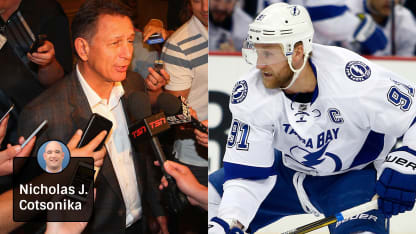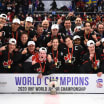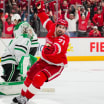The Detroit Red Wings were not left at the altar when Steven Stamkos decided to stay with the Tampa Bay Lightning on Wednesday. They never got to propose.
They were not invited to make a pitch in person during the interview period when Stamkos considered whether to test unrestricted free agency, a huge disappointment for them, much bigger than any other team felt.
Red Wings need new plan after missing on Stamkos
Center's decision to stay in Tampa Bay disappointing for Detroit

No team needed to sign Stamkos more than the Red Wings did, and now it's on to Plans B, C, D, E … as deep as the plans have to go with the free-agent market set to open at noon ET on Friday.
That Stamkos chose to remain with the Lightning for less money than he could have received on the open market underscores why he would have been in such high demand, especially for a team like the Red Wings.
Stamkos is 26 and has averaged 0.55 goals per game in his career, second among active players to Washington Capitals captain Alex Ovechkin. There are three ways to acquire a player like that, and they all come at a high cost.
You can draft him, which means you have to struggle badly and probably have to win the draft lottery. Stamkos was the first pick in the 2008 NHL Draft. Ovechkin was the first pick in the 2004 NHL Draft. Et cetera.
You can trade for him, which means you have to give up a lot of assets and probably have to accept something undesirable in return: a bad contract, off-ice baggage. That's if he's available in trade at all.
Or you can sign him as a free agent, which means you have to sell him on your program and probably outbid every other team, which means he likely creates salary-cap and salary structure problems. That's if he makes it to the market at all.
Stamkos didn't. Most players of his caliber don't, especially under a collective bargaining agreement that allows incumbent teams to sign players to eight-year contracts, one year more than the players could get on the open market.
Signing Stamkos would have been a bonus for teams like the Buffalo Sabres and Toronto Maple Leafs, a boost to their rebuilds. The Sabres and Maple Leafs have struggled and drafted high. Each have restocked their prospect pools and drafted franchise cornerstones: The Sabres took Jack Eichel second in the 2015 NHL Draft; the Maple Leafs took Auston Matthews first in this year's NHL Draft.
Now that Stamkos is staying in Tampa Bay, the Sabres and Maple Leafs don't need to make dramatic moves. They can keep the cap space and the flexibility it provides. They can do something now if it makes sense within their long-term plan but only if it makes sense within their long-term plan. They are on the upswing.
Detroit is different.
The Red Wings have been so successful over the past quarter of a century -- winning the Stanley Cup four times, making the Stanley Cup Playoffs for 25 straight seasons -- that they have not drafted in the top 10 since 1991, when they took forward Martin Lapointe at No. 10. They have not drafted in the top five since 1990, when they took center Keith Primeau third. They have not drafted first since 1986, when they took forward Joe Murphy.
They have not been able to draft a player like Stamkos, but they have defied gravity largely because they struck gold with Pavel Datsyuk, the 171st pick in the 1998 NHL Draft, and Henrik Zetterberg, the 210th pick in the 1999 NHL Draft.
Now Datsyuk is gone, headed home to Russia to play in the Kontinental Hockey League. Zetterberg turns 36 on Oct. 9 and isn't what he used to be. Defenseman Niklas Kronwall is 35 and isn't what he used to be either.
The Red Wings have some promising youngsters, most notably Dylan Larkin, the 15th pick in the 2014 NHL Draft who is coming off a strong rookie season. But they don't necessarily have another Datsyuk or Zetterberg.
There is a strong argument that the Red Wings would be better off breaking their playoff streak and bottoming out, so they could draft high, restock their talent and do a complete rebuild. But that is a long, painful process, and even when you get a player like Eichel or Matthews, you still have a long way to go and no guarantee of success. Ask the Sabres and Maple Leafs.
And ownership hasn't given management that mandate, anyway. The Red Wings are moving into a new arena in 2017-18. They want excitement. They want sellouts. They want to scratch and claw and keep defying gravity as long as possible.
So management is trying to rebuild on the fly. The Red Wings are holding onto their young NHL players, prospects and draft picks as much as possible because they are so precious. That limits the ammunition for trades and makes free agency more important.
The Red Wings have salary-cap space and want to become tougher to play against: faster, bigger, more physical. They're looking mostly at forwards in free agency because no top-pair defensemen could hit the market.
Signing Stamkos would have been a shortcut to a cornerstone, even if it would have come at a high cost in dollars and salary-cap space. There is no one else like him who could hit the market, but there could be many other options, including David Backes, Troy Brouwer, Andrew Ladd, Milan Lucic, Frans Nielsen and Kyle Okposo.
The trick will be selling the right players on the Red Wings program and likely outbidding what should be heavy competition, and not overpaying too badly, especially for older players who have logged too many miles. Easier said than done.
It's hard to defy gravity.

















